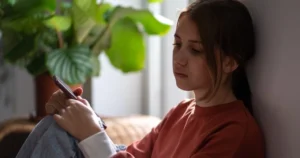The Risks
Connecting with potential love interests online can be fun and exciting for young people but it can also come with potential risks. We explore what these risks are and what you and your teen should look out for to stay safe.
What’s on the page
Are young people equipped to deal with the risks of online dating?
For young people dating online isn’t just about using dating apps – it’s about how relationships develop on social media and through private messaging. Although most children today are tech-savvy, they may not be tech-safe. It’s important to consider that although young people may have been able to navigate the latest apps easily, they may not have built the resilience to deal with issues that come from creating and managing online relationships.
Children and young people with special educational needs and disabilities (SEND) and those that are vulnerable, may be more trusting and socially naive and, therefore more at risk to understand the dangers when forming online relationships.
According to research from LSE: disabled children tend to have more digital skills but encounter more online risk and may lack peer support.
CEOP film highlights why it’s important to talk to children about sex, relationship and the internet.
 Close video
Close video
Exposure to online grooming
Who your children talk to are most likely other children, but some people may not be who they say they are or may be groomed by sexual predators. They may try to trick a young person into believing that they are trustworthy, that they are a friend or they may even pretend that they are the same age.
According to the NSPCC, more than 200,000 secondary school kids have been groomed online (2019 figure).
Advice: Not everyone they meet online will have the right intentions, so it’s important to discuss the risks surrounding online dating such as online grooming and also what signs to look out for to avoid putting themselves in unsafe situations.
Consequences of sexting
If in the wrong hands, a sext, can perpetuate bullying, emotional abuse, revenge porn, harassment, embarrassment, low self-esteem, and even depression.
Advice: Discuss tech dangers – sometimes teens are tempted to send nude photos and unfortunately, there have been cases where these pictures have become public.
Make sure they understand they have the right to say no and that anyone who cares about them should respect that. See our Sexting advice hub to learn more and get support on how to equip your child to make safer choices online.
Online harassment
The more your teen explores the realm of romance online, they may experience unwelcome advances, sexually explicit pictures and general harassment via social media, chat forums and sites, dating apps or messaging services such as WhatsApp and Snapchat.
Advice: If you’re worried about someone your child is in contact with online, it’s important to report these concerns using the appropriate tools on the social media platform they are using. You can also find more information by visiting the CEOP.
It’s also important to note that some social media apps use location services to allow users to see each other’s locations to find potential matches. This could put young people at risk if they are planning to meet someone that they have only connected with online. Having a conversation about potential risks that they could face and putting in place safety rules are essential to keep them safe.
Step UP, Speak UP resource to help young people deal with online sexual harassment
 Close video
Close video
See the report from Project deShame to learn more about teens’ experiences of online sexual harassment.
Privacy concerns
Keeping certain personal information private such as their location, address and where they attend school or college is important. Searching for their name could be a simple way of checking out what information is available about them. Children often share multiple social media handles on these apps, they can give strangers access to more personal information and intimate conversation.
Advice: Using the right privacy settings across all their social accounts and turning off location services, can help them stay on top of what information is available for everyone to see.
Seeking validation from others
Teens will tend to seek validation online so when it comes to dating, they may be more likely to do or say inappropriate things to gain acceptance with someone they may be in a relationship with.
Advice: To ensure they make safer choices, talk to them about a range of topics they may be exposed to while dating online like trust, sex and intimacy. This will help ensure they stay balanced when they come across things that may be incorrect or lead them to believe something that isn’t true.
Limited social interaction
If your teen is only seeking relationships online and neglecting their offline relationships this may hurt their wellbeing. For example, a teen with a long-distance boyfriend in another area may decide not to attend social events, like a party because she wants to stay home to chat with her boyfriend online.
Due to the nature of the online world, young people can easily place a stronger emotional connection with online-only relationships at the expense of friends and family that they know in real life.
Advice: You should regularly check in with your teen to ensure they have a healthy balance between spending time online and offline. You could also remind your child of ways to connect with their peers offline – such as sports, dance drama classes or other social activities.
Supporting resources
See the latest articles on related topics and find resources to support children and young people.
 Research
Research
Preventing ‘self-generated’ child sexual abuse
This report explores effective methods to prevent the sharing of 'self-generated' child sexual abuse material among pre-teens.
 News & blogs
News & blogs
What is undress AI? Guidance for parents and carers
Artificial intelligence continues to increase in ability and technology. Undress AI is one example that could leave young people open to harm.
 Expert opinion
Expert opinion
How schools tackle sexual image-sharing among pupils: Insights from a teacher
Dr. Tamasine Preece shares her experience of sexual image-sharing among pupils in schools.
 Research
Research
Teen girls’ experiences of harm online
Our latest Digital Wellbeing Index report shows that teen girls experience significantly more negative outcomes online than other children.
 Research
Research
Internet Matters x Nominet research: Methods to prevent the spread of self-generated CSAM
In this blog we share findings from Round 2 of our research into the prevention of sexual image-sharing among 11-13-year-olds.





